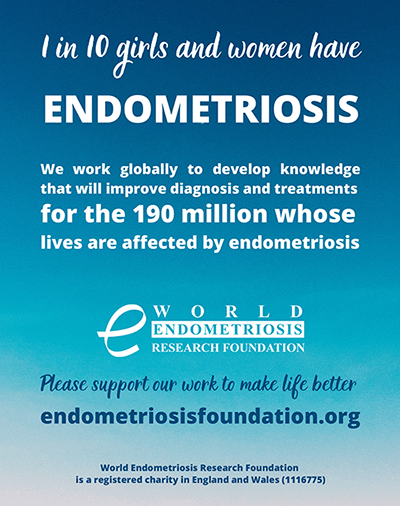When you type “endometriosis” into Google and hit Search, you get something like 6,370,000 matches. Clicking on the definition link at the top gives you this:
A condition, usually resulting in pain and dysmenorrhea, that is characterized by the abnormal occurrence of functional endometrial tissue outside the uterus.
Well, that’s … uh, I have no idea what that means. I’m not a doctor – I’m just a normal person trying to get information. Let’s try somewhere else. What about the Wikipedia? You get this:
A common medical condition where the tissue lining the uterus (the endometrium, from endo, “inside”, and metra, “womb”) is found outside of the uterus, typically affecting other organs in the pelvis. The condition can lead to serious health problems, primarily pain and infertility. Endometriosis primarily develops in women of the reproductive age.

Huh. My eyes glazed over right around “endometrium”…
As I looked at this detailed medical explanation, I thought: all those words, and I still don’t have any idea what it is.
So, out of curiosity, I asked some women who actually have endometriosis to tell me, in their own words, what it is. And you know what I found? Even women with the disease have a difficult time finding the right words to explain it.
That stunned me. It told me that something critical was missing … how do you describe endometriosis (much less say it) in such a way that a non-medical person could understand it? The examples above have important information but they go right over the heads of the people who need the information most: the NON-medical types trying to help themselves and find answers.
This article explores endometriosis, pronounced en-doh-mee-tree-OH-sis (and commonly shortened to “endo”), by putting the dry medical text into regular, everyday language that regular everyday people – without a medical degree – can understand.
Tissue Outside the Uterus
So what was it about the medical descriptions from Google and Wikipedia, that bothered me? It wasn’t that the definitions were inaccurate… because they were detailed and truthful. The problem was that I couldn’t relate to them. They didn’t make any impact on me at all. I mean, the phrase “tissue outside the uterus” sounds so … harmless. Non-threatening. Like, so what?
A more accurate and compelling description of that tissue would actually be “sores or blisters.” Yes, that makes you immediately connect and think “ouch, blister, that’s gotta hurt.” Everyone – male and female – knows what a blister feels like. Even the small ones really sting and hurt because the skin around that area is constantly flexing and rubbing against things… everyone can relate to that nasty jolt you get when you move the wrong way and it scrapes on something. And what if it is located in a spot where it is constantly being irritated? Like on your big toe or the bottom of your foot? The everyday task of walking now becomes quite an annoyance.
And that’s a small blister.
Consider this: a bunch of small unhealed blisters; each filled with fluid and the skin around them red raw and irritated.
Now picture them inside your body – in your abdomen, peppered along your intestines or your bladder. When your bladder fills up, it gets bigger which stretches the sores along the outside of it and causes – you got it – pain. Or worse, it causes the blister to pop. And unlike a blister on the outside of your body, this fluid leaks out into your abdomen where it gets stuck with no way to get out. So it stays and makes more blisters. Yeah, you heard me right – it spreads. Awful huh? So now, instead of one blister, you have the beginnings of others that will get bigger until they too pop and spread. Argh!!!! That gives a whole new meaning to “tissue outside the uterus”, doesn’t it?
Help is on the way – Or is it?
However, all is not lost! The body is a wonderful healer, and it tries to heal those blisters by creating protective scar tissue around them, just as it does with a sore or scrape on say, your leg. You probably have an old scar… think about how the skin feels. Is it loose and flexible? Or is it bumpy and stiff, thicker than the rest of your skin?
Unfortunately, even though the body is trying to help, the scar tissue in your abdomen can be just as much of a problem as the initial blister or sore that caused it. This is because there are many different organs bunched together in a very small area – bladder, intestines, ovaries, fallopian tubes, uterus, and so on. The scar tissue sometimes gets stuck to things other than what it is supposed to be healing. And “stuck” is the perfect word for what happens; scar tissue can grab things just like a cobweb — sticking and clinging to anything that it comes in contact with. Once it settles, it hardens and starts pulling and tugging on the surrounding organs… making everything tight and immovable which equals – you got it – pain.
But what causes it?
So back our original definition: when you read “tissue outside the uterus” … well, you can see that phrase doesn’t even begin to cover it. Plus, in all of these descriptions of endo, you never read why these blisters or sores happen to begin with! When you get a blister or a paper cut or a scrape on your leg, you can usually trace back to the moment that it happened. It was caused by something… but what about endometriosis? What causes it?
Lots of people have lots of theories but they are only theories, not proven fact. We’ll explore some of these theories later but for now, the only facts they know for sure are:
- The blisters or cysts are actually made of the same kind of material.
- That material should exist in only in one place: inside your uterus. It is the same material that sheds and comes out of the body when a woman has her period.
- Somehow that material escapes out of the uterus and goes into the abdomen, where it continues to bleed and spread just as if it was still in the uterus.
- One specific kind of hormone causes this material to remain “active” and able to spread. Unfortunately that hormone is critical to women and it is called estrogen.
I can almost hear you now: so let me get this straight… you are telling me that stuff the blisters are made of should actually only exist in the uterus but with endometriosis, it escapes and goes outside the uterus?
Yup.
And that it spreads onto other organs when it gets a whiff of a certain chemical called estrogen?
Right again.
And there is no way for any of this stuff to leave the body… it is trapped in the abdomen?
Unfortunately, yes.
And all of this is made worse when the body tries to heal itself and makes scar tissue?
Yup.
So why doesn’t someone just figure out how to stop it from escaping out of the uterus? Wouldn’t that make the disease stop?
Good question. Er… here’s the thing: specialists in endo, from all over the world are working on solving that problem even as you read this article. One of those doctors, Dr. Andrew Cook, we’ll even talk about more later. But truth is that no one knows for sure how that tissue gets out of the uterus. Which is a shame since that would put doctors on a path to curing this disease, right? If they could stop the sores from appearing in the first place, then we wouldn’t have any scar tissue either and we wouldn’t be needing articles like this one.
Pain: Small word, with a BIG meaning
The other thing that bothered me about those definitions that we saw in the beginning was the word “pain.” How can anyone relate to something so general a description? I mean everyone has some kind of pain – how bad can it possibly be?
Well, given the information we just discussed, you have a little better idea and probably think, yeah, I’d hate to have that. You might even say “That sounds awful, what a horrible thing to have to deal with.”
I don’t know about you, but I’m still left with questions in my mind – I don’t have a clue what it would actually be like to have those sores inside me. Would it be like a stomach ache? Or the throbbing pain in your intestines when you have a virus? Or the dull ache/pain of a muscle strain? Or bad cramps you might get with period pain? The specialists that treat this disease are faced with the same problem: they need to know where it hurts, what the pain feels like, how long it lasts, when it comes on, and so on… that is the information that is absolutely critical to a doctor being able to successfully diagnose and help.
So endo specialists listen for key words that women use to describe their pain. Because of the blisters and sores that endo causes, it cab create specific, distinctive patterns of hurt. Depending on the words a woman uses, the doctor can develop a more accurate picture of what might be happening inside at that moment. For example, using words like “stretching and tugging” now have a very different meaning given what you just read about scar tissue, right? Some doctors, like Dr. Cook, have even gone a step further and created a special list of words for women to choose from to help describe what they are feeling. Some of the commonly used words include: throbbing, burning, piercing, stabbing, aching, tearing, pounding, to name a few. Even though these words read like a script of a horror movie, they are in fact typical of the types of pain that endo causes.
Just as important as how it feels is where… Another useful tool that many specialists, like Dr. Cook, have discovered is the use of a “pain map”. What is a pain map? A doctor hands a woman a drawing of the body along with a pen. She then draws Xs on the picture in the locations where she has each area of pain. There are so many different places that this disease can affect – lower abdomen, upper abdomen, left or right sides, lower back, inside and top of the thighs, and so on.
Interestingly, women who have endo that have never met or even talked with each other about their pain choose the same words to describe some of their pain… they even draw their pain in the same places when describing what it feels like. Years of research and studies have all shown that, in many cases, these words and the pain maps that go along with them actually match what is going on insidethe body! How do the doctors know it is the same? Some of these specialists are experienced surgeons and, as one of the ways to help diagnose a woman, they can look inside with special instruments and see for themselves what is happening. This type of procedure is called a laparoscopy (pronounced lap-a-ros-co-py) and it an extremely safe way to diagnose and help someone with endo. Learn more about this in the “What Can A Doctor Do?” section.
Look at all of the focus put on one small but incredibly important word? Pain. When that word is used in context with endometriosis, it comes along with its own vocabulary and even drawings that map out the locations of all the spots that hurt and that potentially have endo.
So what does a doctor do with that? Now that the doctor has all that information, can’t he or she FIX it??
So Just Fix It Already
Doctors can help a woman with endo but, just as they don’t know why it escapes from the uterus to begin with, they can’t fix it.
There is no cure.
And here is an even more sobering thought: there are some doctors out there who actually think that this is all in your head! Is that unbelievable or what? They say that “pain during the month is normal,” or “pain can’t be THAT bad – are you sure it is that bad?”.
Uh, I don’t know about you but if I have pain that feels like piercing, throbbing, and burning, I’d have to say that is NOT normal. Anyone who dismisses you without even listening or trying to help you figure out why you feel so awful isn’t worth your time. If you have pain that disrupts your daily life, then something is not right. You have one life: if you spend one week of every month of your life in pain, that is a HUGE amount of time! Twelve weeks during the course of a year! Never allow someone to dismiss you when you know something is wrong. Find a doctor who will listen – and there are good ones out there — and get your life back: that is the smartest decision you’ll ever make.
What Can A Doctor Do?
After you ditch the unhelpful doctor, you do some research and make an appointment with someone who does listen. Can they do anything to help?
I am happy to report, that there are things a doctor can do to help someone with endo! And even though they can’t cure the disease, there are plenty of ways to get things moving in the right direction and address what is wrong.
We’ve talked a little about surgery but there are other treatments as well: there are a variety of medications that can help to regulate your hormones or even quiet your ovaries so they are not releasing as much estrogen. The goal in using medication is to give your body a break and allow those blisters a chance to shrink – which they will do when the estrogen in your body is reduced. Finding a doctor who is knowledgeable in the latest research and proactive in keeping on top of all the new information is very important. This is your health andyour life – it is worth the time to find the very best doctor out there.
©Copyright Wendy Vogt
By Wendy Vogt, a patient of Dr. Andrew Cook
http://www.vitalhealth.com
Vital Health Institute
15055 Los Gatos Blvd., Suite 250
Los Gatos, CA 95032-2025
(408) 358-2511

